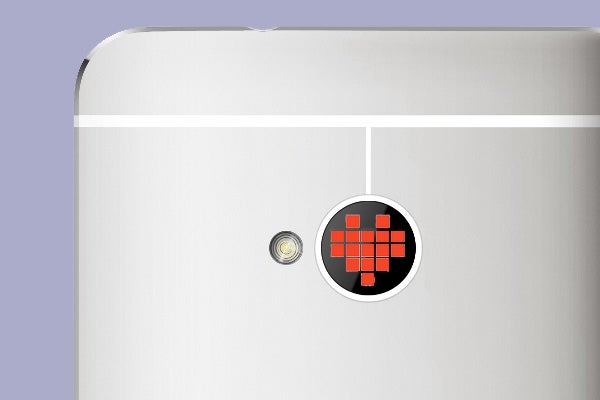I’d love a Samsung Galaxy S4, but I’d rather have an HTC One

The secret’s out. We now know what almost all the biggest Android phones of the year will be, short of a Mighty Ducks-style miracle turnaround from a lesser phone maker like Alcatel.
Top of the tree are the Samsung Galaxy S4, the HTC One and the Sony Xperia Z. All we’re waiting for is the rumoured Google Nexus 5 to complete the set.
No matter how good the phones are, no matter how many sides of buses are splattered with images of these mobiles, Samsung’s victory is all-but secured. And the phone hasn’t even been released yet.
The Samsung Galaxy series has become the ruler of the Android realm, and there’s no way we can think of for Sony and HTC to catch up in this generation. Short of Samsung accidentally making the Galaxy S4 out of asbestos, that is.
Much as you may simply accuse us of favouring the underdog, the phone I’d like to lovingly keep in my pocket every day, slowly scratching it to death in a sea of shrapnel and house keys, is the HTC One.
There is a lot of support for HTC’s latest phone online, support that was much less markedly apparently for last year’s HTC One X. So what’s so special about the latest phone?
Hitting nails
HTC, more than most other phone makers, has been happy to experiment with different approaches to phone design. It has produced ceramic phones, metal phones and, yes, at times plastic phones.
This mish-mash approach has led to some design classics – the HTC Legend, for example – but has also arguably led to an unclear brand image. What is HTC about these days? Does anyone know anymore?
However, the HTC One represents a re-focusing of HTC’s aims. In short, it has aced the phone’s hardware design. More so than the Sony Xperia Z. More so than the Samsung Galaxy S4.
I’ve put the HTC One in the hands of around a dozen people, and the same response has always followed – something along the lines of “wow, that’s a nice phone.” Occasionally it’d be followed by “I’d hate to think what would happen if I dropped it.” But that’s beside the point.
In contrast, the Sony Xperia Z is all rubber lined flaps that dangle like flailing limbs given half the chance, and glass you’d mistake for plastic if you weren’t faced with a clear specs lists that contradicts that. And the Samsung Galaxy S4 is just a Galaxy S3 that’s wearing more effective mascara and has given up on dinners for a few weeks. Samsung didn’t need to change its hardware design significantly. So it didn’t.
Add in the technologically interesting “UltraPixel” camera of the HTC One, compared to the me-too 13-megapixel sensors of the Samsung Galaxy S4 and Sony Xperia Z and you’ll realise the HTC is one of the only truly hardware-focused flagship phones of the year.
What confirmed the Samsung Galaxy S4’s lack of hardware inspiration was the announcement that none of the main Western markets would get the phone running an eight-core processor. We’re stuck with the more familiar four-core type – which is likely to offer poorer battery life, if not markedly poorer performance.
If the Samsung Galaxy S4 isn’t about hardware, what is it about?
Soft-core
The Samsung Galaxy S4’s focus is clearly on software. We’ve long argued that at this point of hardware saturation, a software focus is the way forward. However, Samsung’s approach in this field is like a child who bounds up to you every five minutes with a drawing they’ve just made, all excited, but a quick glance tells you that most of the drawings are a bit rubbish. Yes, Smart Scroll, we’re looking at you.
Even these extras are all based on foundations that were setup last year with the Samsung Galaxy S3, or even earlier. Maybe phones don’t have to be exciting to be good, but progress based on sequential increases in specs is too often not real progress at all.
The Samsung Galaxy S4 camera sounds like it’s a huge upgrade over the Samsung Galaxy S3’s, with a 13-megapixel sensor over the S3’s eight-megapixel jobbie. But it’s not that simple. They use roughly the same-size sensor, which means that the sensor’s light-grabbing pixels have to be much smaller than those of the S3.
Smaller pixels means less area within which to take harvest light. Samsung has tried to compensate for this by using a faster lens, but it’s still possible that low-light performance in the Galaxy S4 will be worse than that of the S3. Cue fast intake of breath.
There was a reason phone makers started rolling back on megapixels – the first 12-megapixel phone was released in 2009. That’s ancient history in smartphone terms.
The HTC One’s UltraPixel camera may not be a complete success, but it at least bucks the megapixel trend. Realising the problem with using teeny tiny sensor pixels, HTC uses a similar sensor size to the Galaxy S4, but packs in far fewer megapixels.
It’s a one step back, two steps forward ideal.
Less = more?
The less-is-more motif is in evidence throughout the HTC One’s software. By default it crams in less app icons than other phones, and aside from the BlinkFeed-Zoe-UltraPixel mantra the phone feels refreshingly free of gimmicky gadgety nonsense.
To pick the HTC One is to opt for an altogether classier phone that’s out to revert a few destructive mobile trends. And to me, that sounds like a pretty darn good thing.
If the HTC One is at the top of your most-wanted list, let us know why in the comments.


